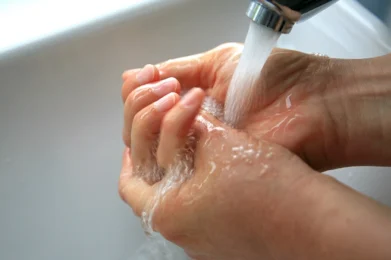In This Article:
- To stop bleeding, first try applying direct pressure. Once the bleeding stops, tie a cloth, gauze or towel tightly around the wound without cutting off circulation.
- If the bleeding is severe and won’t stop with direct pressure, assemble a tourniquet — a tight band used to stop blood flow — to keep the patient from developing shock.
- Keep the following tools in your emergency first aid kit: bandages, gauze, 1 emergency blanket, 2 pairs of nonlatex gloves, gauze roller bandage, 2 triangular bandages, tweezers and aspirin.
How to Provide First Aid to Stop Bleeding
In the face of an emergency, most peoples’ first instinct is to figure out a way to call 911 as soon as possible. This is an important instinct that should never be ignored – but are you prepared to provide emergency first aid for yourself or another injured person in the minutes before help arrives?
We believe everybody should know basic first aid methods to provide self-care or care for other injured people in an emergency. Even if you’re lucky enough to call for an ambulance that’s only a few minutes away, every second counts when it comes to emergency care. Knowing how to stop severe bleeding before professional medical help arrives could significantly help someone’s ability to fully recover, and in some circumstances, could even save their life.
What to do before helping someone who’s injured
The first step to being able to help anyone in an emergency situation is recognizing someone who needs help to begin with. Sometimes a person who is bleeding may not cry out for help, and the adrenaline of the moment may make it difficult for them to feel pain or fully grasp the severity of their injury.
If you’re uninjured and are in an emergency situation, pay attention to those around you who might be in need. Before you proceed to help them, make sure you’re safe – if you’re a victim, you won’t be able to help anyone. Try to move the injured person to a safe, level surface – for instance, if they’re on a hill, try to carefully help or carry them up to a sidewalk; if they’re in the middle of a crowd, carry them to an uncrowded space.
Before you begin caring for someone’s wound, and if you’re not certain where they are bleeding from, try to expose the bleeding wound. Do not attempt to remove anything from the wound or force anything out of the wound that is difficult to get out or stuck.
Applying direct pressure
One of the most important techniques for stopping severe bleeding fast is applying direct pressure to the wounded area using a heavy gauze pad, towel, shirt or other folded cloth. If the blood soaks through the first cloth, find another cloth to place over the first cloth – do not remove the first cloth or relieve any pressure. Keep adding a new cloth every 10 minutes until the bleeding stops or until help arrives.
Once the bleeding appears to have stopped, tie the cloth firmly in place with any supplies you may have around (e.g. shoelaces, neck ties, strips of sheet, etc.). Tie with enough pressure ‘as tight as it takes’ to keep the wound from actively bleeding, as you’ll risk cutting off blood flow to the rest of the limb and you are not using it as a tourniquet.
If the injured person is bleeding severely out of their arm or leg, keep the limb elevated above heart level.
How to stop severe bleeding using tourniquets
A tourniquet is a tight band used to stop blood flow to a wound and keep the patient from developing shock.
Generally speaking, a tourniquet should only be used in two situations:
- If direct pressure and elevation have both been applied simultaneously, and the bleeding still isn’t showing any signs of slowing down or stopping
- If direct pressure can’t be maintained
A tourniquet should only be used for severe uncontrolled bleeding situation, if no other method is working. People commonly have to use this method in the case of emergencies such as car accidents, gunshot wounds, deep cuts or crushed limbs. Ideally, a first responder should be the one to administer a tourniquet, but there are ways to do it yourself if it’s necessary to use before medical help arrives.
According to Very Well Health, homemade tourniquets are effective up to 30-35 percent of the time. Note that tourniquets are only to be used on injured limbs, and cannot be used for injuries on the head, neck or torso. Remember, a tourniquet should only be used after direct pressure has been applied, and only if that direct pressure is not slowing or stopping the bleeding on its own.
To assemble a tourniquet using supplies you have at home, you will need something to wrap around the limb, such as a triangular bandage, belt, towel or shirt. You will also need something to use as a “windlass” (such as a stick, pencil or spoon). The windlass is essentially a lever that can be used to tighten the tourniquet.
First, find the source of the bleeding. Be aware that applying a tourniquet can be very painful for the injured person – however, it is often a critical measure that may save the person’s limb, if not their life.
Next, position the item you are using for the tourniquet several inches above the injury. The tourniquet needs to be positioned at the part of the limb that is closest to the heart. If the injury is beneath the knee or elbow, the tourniquet needs to be applied above the joint. Tie the fabric into a knot, making sure to leave enough length out.
Grab your stick (or any item you are using as a windlass), place it on the knot, tie the loose ends of the tourniquet (fabric) around the stick, and begin twisting the stick to increase the pressure. Continue turning the stick until the bleeding has stopped or is significantly reduced.
Keep in mind that you should not leave a tourniquet on for more than two hours. You will need to make a note of what time you applied the tourniquet so the paramedics can see when they arrive.
What tools should I keep in my emergency first aid kit?
Though you may not always have access to an emergency first aid kit in every situation, it is a good idea to gather some essential supplies and keep the kit with you in your car and home. Examples of supplies you should keep stocked in your kit include (but are not limited to):
- Bandages (assorted sizes)
- Gauze (we recommend this QuikClot (hemostatic gauze) products from Z Medica)
- 1 emergency blanket
- 2 pairs of nonlatex gloves
- Gauze roller bandage
- 2 triangular bandages
- Tweezers
- Aspirin
If you or a loved one are ever in need of emergency care, Valleywise Emergency – Maryvale and Valleywise Health Medical Center are here to care for you 24/7. Visit our website or call 1 (833) VLLYWSE to learn more. In the case of an emergency, call 911.
Sources:
- https://www.healthline.com/health/first-aid/stopping-bleeding#cuts-and-wounds
- https://quikclot.com/QuikClot/Products
- https://www.redcross.org/get-help/how-to-prepare-for-emergencies/anatomy-of-a-first-aid-kit.html
- https://www.verywellhealth.com/how-to-use-a-tourniquet-1298298
- https://www.health.harvard.edu/staying-healthy/emergencies-and-first-aid-direct-pressure-to-stop-bleeding
- https://www.healthline.com/health/first-aid/stopping-bleeding#cuts-and-wounds
- https://www.stopthebleed.org/







